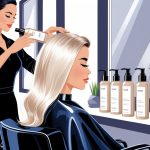New Hair Color Formulas Secretly Reducing Salon Visits for Professionals
Frequently Asked Questions
All these new pro color formulas, hyped as “long-wear” and “fade-proof,” sound like we’ll finally stop getting those frantic “help, my roots!” texts. If even half these claims are true, maybe we’ll all spend less time fixing disasters. Maybe.
What are the long-lasting hair color products that can help clients extend time between salon visits?
Honestly, I keep ending up with demi-permanent glosses and those so-called “hybrid dyes”—Wella Illumina, Redken Shades EQ, you name it, every brand’s got their own “long wear” claim. Demi-permanent color’s weirdly satisfying because it just deposits pigment without totally frying your cuticle, so the fade-out isn’t as tragic. According to Wella’s breakdown of glossing, the tradeoff is you lose some lift, but honestly, I’d rather have my color a bit deeper than watch it go orange halfway through the month.
There’s always this rumor (or, whatever, marketing nonsense) that oxidative “mega-hold” creams buy you three extra weeks between appointments. I haven’t seen any actual studies—has anyone?—but my clients who stick with these formulas do seem to stretch out their salon visits. Maybe it’s placebo, maybe not, but a couple less appointments a year? I’ll take it.
How can I maintain my new hair color and keep it looking fresh without frequent salon appointments?
I once watched a stylist nearly combust when a client insisted on using clarifying shampoo right after getting her hair colored. Like, do you enjoy throwing money away? I don’t get it. Picking sulfate-free, color-safe shampoos (which, yeah, every expert on Earth repeats until it’s white noise) actually does help—color-safe care is non-negotiable.
Sunlight and hot tools just eat color alive. I keep telling myself to use a UV-filter leave-in, and then I forget, so I guess I lose that round. Dry shampoo, especially the talc-free kind (because scalp health matters, apparently), does keep my roots looking less tragic and somehow slows fading, even if I don’t totally buy the science.
What innovative techniques can professionals use to ensure hair color lasts longer?
Lately, I keep seeing stylists obsess over micro-sectioning, like, they’ll do strand-by-strand applications and swear it means less banding and better coverage. Sometimes it actually looks like you never even had roots until your hair’s grown out a mile. Glazing over highlights instead of just toning, alternating direct dyes with ammonia-free stuff, or pulling gloss through the mids every other session—these tricks are everywhere now.
People always say “low and slow” for processing color, and I get why. Rushing developer or blasting heat? I swear it just makes color fade faster. Some stylists will use a lower-volume developer for longer, insisting it locks in pigment better. Maybe it’s just superstition, but honestly, I’m not arguing.
Are there any at-home treatments that can preserve professional hair coloring results?
Yeah, so weekly color-depositing masks (the ones that stain your hands, so don’t forget gloves unless you want purple fingers) help keep brassiness at bay. Just don’t go nuts—one of my clients once tried to “neutralize gold” and ended up with teal roots. She blames the lighting. Sure.
Professional leave-ins with UV filters? Way more useful than most people think. Olaplex No. 3 or whatever dupe you find, people talk about them nonstop on forums. And then there’s the coconut oil crowd, hoping for miracles—look, oil might make your hair feel soft but it’s not saving your color. Sorry.
What ingredients should I look for in hair color formulas that promise longer-lasting results?
Ammonia gets a bad rap, but sometimes you need it for real pigment (even if the smell is burned into my brain forever). MEA (monoethanolamine) shows up in “gentler” formulas—if you care about that stuff, it apparently swells the cuticle less, so less color runs out in the shower.
Brands love to brag about cationic polymers and “micro-pigment tech”—basically, molecules that cling to your hair like a needy ex. Antioxidants like vitamin E or random plant extracts keep popping up in these “long-lasting” glosses too. If your formula reads like a vitamin label, with UV absorbers and wheat proteins, it’s probably trying to fight fading. Whether it works? Who knows. I just want my hair not to look like a traffic cone after three weeks.
Can changing my hair care routine help in maintaining my color and reducing salon visits?
Okay, so, does anyone actually enjoy freezing showers? I keep hearing that cold water keeps your color in longer—sure, maybe, if you’re into shivering and speed-washing. I last, what, 20 seconds before caving and cranking up the heat. Supposedly, I’m supposed to shampoo twice a week, tops, and only with “color-safe” stuff. But my scalp? It’s staging a protest by day three. I can’t be the only one who gets itchy and weird after skipping washes.
And then there’s the whole heat styling guilt trip. Everyone says, “Don’t use hot tools!” or, if you must, slather on heat protectant like your life depends on it. It’s fine until you remember you have, like, five minutes to get out the door. I tried that “no-poo” thing once—let’s just say my hair color stuck around, but I smelled like a questionable science experiment. Can’t win. Is it better to have faded color or hair that actually feels clean? I still have no idea.



